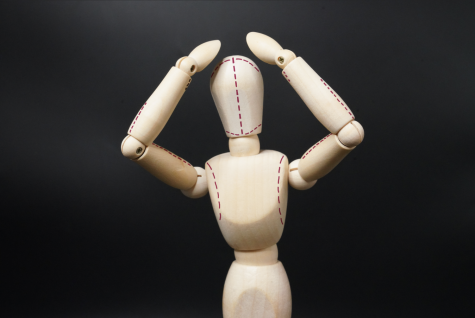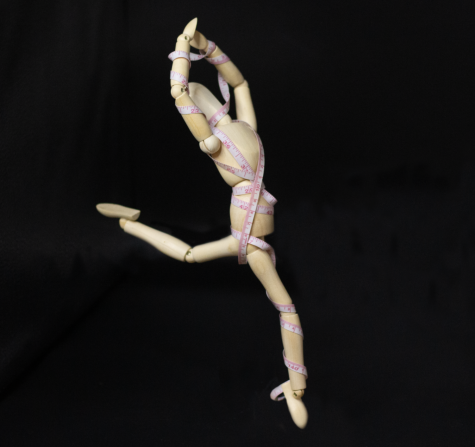Trapped in the tape measure
Examining how beauty standards in performing arts impact MVHS athletes
April 12, 2023
Content warning: this article discusses eating disorders.
After a particularly hard dance lesson during which her teacher was critical of her technique, sophomore Hemani Kamarshi found herself looking in the mirror. She stared at her body, a sense of shame emerging the longer she looked at herself. Kamarshi, who participates in Bharatnatyam, a type of Indian classical dance, found herself wondering whether her body was simply “just not right” for her sport.
Freshman and ballerina Isabelle Kok finds that beauty standards that pressure athletes to be slimmer are more exclusive to artistic sports. Senior and former ballerina Lauren Lin agrees, saying that when participating in these sports, which include dance, figure skating and gymnastics, athletes are often pressured to be skinnier.
“Looking at your body image is unavoidable,” Lin said. “You’re always looking at yourself in the mirror while doing movements, and it’s all about the placement of your body. You’re forced to look at yourself.”
Many beauty standards emphasizing leanness are often deeply woven into the culture of their respective sports — Kamarshi notes that standards which are prevalent in India pressure her to look slimmer and to have large eyes, full lips and long eyelashes. Similarly, sophomore and rhythmic gymnast Yuzuki Ito has found that there is an expectation in gymnastics for athletes to be lean, which she traces back to the origin of the sport.
“The sport originated in Russia,” Ito said. “Coaches there are crazy strict about [their gymnasts’ weight]. I think this sport circles so much about the [idea] that [you] have to be skinny. I think that’s a toxic environment that is very normalized.”
Ito notes that while coaches in America may not be as strict about monitoring their athletes’ weight, the expectation to be skinny is still prevalent. Both her coaches and parents emphasize leanness, so her conversations with her coach often revolve around being disciplined about what she consumes.
“When you’re at a convention, you compete in a leotard that is tight on your body,” Ito said. “I’ve never ever heard anyone not talk about comparing themselves at a convention. Unfortunately, I’ve also seen parents videotape people who are a little bit out of the range for what’s been viewed as skinny, videotape them and then post it, saying ‘How can someone let this child get this far?’ It’s disgusting.” If you have the kind of body that lends itself to ballet and to the [beauty standard], you’ll be able to go further. — Freshman Isabelle Kok
The media only perpetuates body image struggles since ballerinas in professional companies and those who get lead roles are usually really skinny, and Lin notes that it pressures athletes to fit that standard, despite it being unattainable. This causes ballerinas to develop insecurities with their body image and compare themselves to their peers. Kok explains that athletes are always being compared to their peers — they are favored by judges if they are skinnier and are often given better roles or scores.
“Whenever you’re auditioning for a role, your goal is to look as attractive as possible,” Kok said. “People who judge the auditions aren’t always focused on technique. They’re focusing on how pretty you look and how you look on stage. So if you have the kind of body that lends itself to ballet and to the standard in ballet — which is being skinny — then you get more opportunities within the dance world and you’ll be able to go further.”
Ito says coaches can sometimes worsen the pressure placed on athletes by comparing them to each other — her coaches tend to point out when one person is doing an exercise or movement better than the other. Kok also notices that coaches can have a large influence on the pressure athletes place on themselves.
“There are teachers that constantly break you down and criticize you for how your body looks or set unreachable standards for how you should look,” Kok said. “That can cause a lot of people to grow disconnected from the sport and what made them want to join the sport in the first place. There’s so many people who have had to quit dance, or quit other sports simply because of how much pressure there was in the environment that they were in.”
Kamarshi recalls her self-perception being damaged by the pressures that have been perpetuated by her teacher and her sport. She found herself wanting to be slender, even feeling obligated to begin counting calories.
 “I would wake up and look in the mirror and think, ‘Oh my god, I’m fat,’” Kamarshi said. “I would go to bed hungry because I was eating too few calories. I intentionally did that to see if I could lose weight, and I was weighing myself every two to three days.”
“I would wake up and look in the mirror and think, ‘Oh my god, I’m fat,’” Kamarshi said. “I would go to bed hungry because I was eating too few calories. I intentionally did that to see if I could lose weight, and I was weighing myself every two to three days.”
Ito recalls a similar experience. At one point, her body image was so distorted, she remained unsatisfied with how she looked despite “looking skin and bones from a normal perspective.” Ito recalled losing way too much weight, experiencing a loss of focus, constantly thinking about food and always feeling cold.
“I had a really bad eating disorder where I would limit my calorie intake to 800 every day,” Ito said. “I lost way too much weight — I was 20 pounds underweight, just below 70 pounds. And I still looked at myself and thought I wasn’t enough. In the summer it got so bad to the point where I would eat 600 calories a day with seven hours of intense training and conditioning and cardio. My idea of skinny was becoming more and more distorted, and it genuinely destroyed my body image and my courage to be healthy.”
Lin also faces long-term impacts of beauty standards surrounding ballet — she says she still feels pressure to maintain a skinny body despite gaining weight being a natural aspect of getting older. I feel a pressure to maintain the image of the younger version of me that everyone labeled as the skinny one, even though it’s not attainable. — Senior Lauren Lin
“When I was younger, a lot of people would say I was really skinny,” Lin said. “So I feel a pressure to maintain that. I left ballet two years ago, but I still notice things about my body, and as I grow older, I feel pressure to maintain that image of the younger version of me that everyone labeled as the skinny one. I think it’s permanently affected me and I’ll always feel pressure to maintain that, even though it’s definitely not attainable.”
Ito explains that these standards often leave permanent impacts on athletes, which she feels as though she can’t escape from and “doesn’t think [she] ever will.” She says gymnastics has permanently distorted the way she sees herself, urging her to watch what she eats even after quitting. However, she finds that despite watching what she eats in the hopes of being satisfied with how she looks, she will never attain that satisfaction.
Lin says that ultimately, coaches should not comment on athletes’ bodies at all — even though coaches may think their comments are positive, athletes might perceive them the opposite way. She thinks that in order to combat harmful effects of beauty standards, coaches should take action by trying to include people to be lead roles even if they may not fit the beauty standards and by being mindful of how their words can affect their students. However, Kok finds that coaches may not decide to take action against traditional beauty standards.
“I feel like this is a personal journey that everyone has to make about whether or not they want to advocate against the standards,” Kok said. “Because although these standards are obviously harmful to everyone, you can’t be too controversial if you want to go far in the dance world. Sometimes you have to choose between fighting for what you think is right and being able to afford the opportunities you really want.”
















